wounds
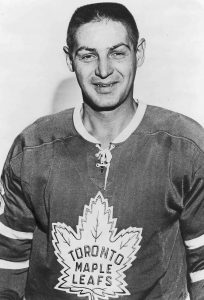
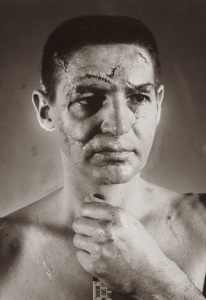 If you could see all of Terry Sawchuk’s wounds at once, his face would look like this one that was reproduced with makeup. In reality, Terry’s wounds have healed over the years, and the scars are not nearly as visible as the makeup reproduction portrays. Nevertheless, Sawchuk’s 16 years of playing goalie for the Toronto Maple Leafs hockey team in the years before the goalies wore safety equipment left their marks and took their toll on his body. Re-created here, by a professional make-up artist and a doctor, are some of the more than 400 stitches he had earned during 16 years in the National Hockey League. Terry Sawchuk’s face was bashed over and over, but not all at one time. The re-creation of his injuries was done to help show the extent of his injuries over a span of years. Sawchuk had sustained other injuries that were not shown here too…a slashed eyeball requiring three stitches, a 70% loss of function in his right arm because 60 bone chips were removed from his elbow, and a permanent “sway-back” that was caused by a continual bent-over posture during the games.
If you could see all of Terry Sawchuk’s wounds at once, his face would look like this one that was reproduced with makeup. In reality, Terry’s wounds have healed over the years, and the scars are not nearly as visible as the makeup reproduction portrays. Nevertheless, Sawchuk’s 16 years of playing goalie for the Toronto Maple Leafs hockey team in the years before the goalies wore safety equipment left their marks and took their toll on his body. Re-created here, by a professional make-up artist and a doctor, are some of the more than 400 stitches he had earned during 16 years in the National Hockey League. Terry Sawchuk’s face was bashed over and over, but not all at one time. The re-creation of his injuries was done to help show the extent of his injuries over a span of years. Sawchuk had sustained other injuries that were not shown here too…a slashed eyeball requiring three stitches, a 70% loss of function in his right arm because 60 bone chips were removed from his elbow, and a permanent “sway-back” that was caused by a continual bent-over posture during the games.
Many people were hurt playing sports in the years before safety equipment was used. For some of them, like Sawchuk, the equipment would not come in time to spare them from years of pain, and even disabilities. It was 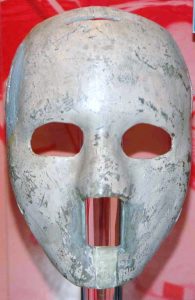 a sad reality of many sports that everyone loves. The first goalie’s mask was a metal fencing mask donned in February 1927 by Queen’s University netminder Elizabeth Graham, mainly to protect her teeth. In 1930, the first crude leather model of the mask, which was actually an American football “nose-guard” was worn by Clint Benedict to protect his broken nose. After recovering from the injury, he abandoned the mask, never wearing one again in his career. At the 1936 Winter Olympics, Teiji Honma wore a crude mask, similar to the one worn by baseball catchers. The mask was made of leather, and had a wire cage which protected the face, as well as Honma’s large circular glasses.
a sad reality of many sports that everyone loves. The first goalie’s mask was a metal fencing mask donned in February 1927 by Queen’s University netminder Elizabeth Graham, mainly to protect her teeth. In 1930, the first crude leather model of the mask, which was actually an American football “nose-guard” was worn by Clint Benedict to protect his broken nose. After recovering from the injury, he abandoned the mask, never wearing one again in his career. At the 1936 Winter Olympics, Teiji Honma wore a crude mask, similar to the one worn by baseball catchers. The mask was made of leather, and had a wire cage which protected the face, as well as Honma’s large circular glasses.
Finally, in 1959 goalies began wearing masks full-time. On November 1, 1959, in a game between the Montreal Canadiens and New York Rangers of the National Hockey League, Canadiens goaltender Jacques Plante was struck in the face by a shot from Andy Bathgate. He had previously worn a face mask in practice, but coach Toe Blake refused to allow him to wear it in a game. He thought it might inhibit his vision. After being stitched up, Plante gave Blake an ultimatum. He refused to go back out onto the ice without the mask. Blake agreed, not wanting to forfeit the game, because NHL teams did not have back-up goalies at the time. Plante went on a long unbeaten streak wearing the mask. That ended when he was asked to remove it for a game. After that particular loss, Plante resumed donning the mask for the remainder of his career. Plante was ridiculed when he introduced the mask into the game. People questioned his dedication and bravery. In response, Plante made an analogy to a person skydiving without a parachute. Although Plante faced some 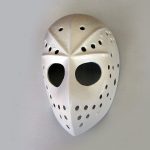
 teasing, the face-hugging fiberglass goalie’s mask soon became the standard. Since the invention of the fiberglass hockey mask, professional goalies no longer play without a mask. The last goalie to play without a mask was Andy Brown, who played his last NHL game in 1974. He would then go to the Indianapolis Racers of the WHA and play without a mask till his retirement in 1977. So much has been learned about playing without protective gear since those days, but for the people who played before all that information, it came at a heavy price.
teasing, the face-hugging fiberglass goalie’s mask soon became the standard. Since the invention of the fiberglass hockey mask, professional goalies no longer play without a mask. The last goalie to play without a mask was Andy Brown, who played his last NHL game in 1974. He would then go to the Indianapolis Racers of the WHA and play without a mask till his retirement in 1977. So much has been learned about playing without protective gear since those days, but for the people who played before all that information, it came at a heavy price.
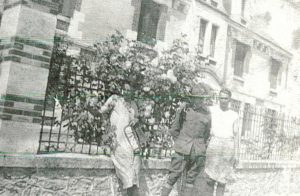 War is never pretty, and yet somehow, I had a picture in my head of the time my grandfather, George Byer spent in World War I that made it seem very benign. I never pictured him being in any danger. You see, my grandfather was a cook in the Army during the war, and somehow I pictured him working in a safe place where the war was a very distant reality, and not something to be faced or dealt with. The cooks in World War I didn’t even get a gun, so they must not be in danger…right? Wrong…very wrong!! The men on the front couldn’t drive home to the safety zone every night after work, like I had pictured in my head. The kitchen was very close to the front. In Grandpa’s case, that kitchen was a commandeered kitchen in the lowest floor of a French castle. As far as anyone knows, the residents of the castle still lived there, although I’m not sure how their meals were handled. Perhaps, their own cooks were allowed a little time in the kitchen, or maybe their meals were served along with the men in the Army. I don’t suppose we will know the full answer to that question in this lifetime.
War is never pretty, and yet somehow, I had a picture in my head of the time my grandfather, George Byer spent in World War I that made it seem very benign. I never pictured him being in any danger. You see, my grandfather was a cook in the Army during the war, and somehow I pictured him working in a safe place where the war was a very distant reality, and not something to be faced or dealt with. The cooks in World War I didn’t even get a gun, so they must not be in danger…right? Wrong…very wrong!! The men on the front couldn’t drive home to the safety zone every night after work, like I had pictured in my head. The kitchen was very close to the front. In Grandpa’s case, that kitchen was a commandeered kitchen in the lowest floor of a French castle. As far as anyone knows, the residents of the castle still lived there, although I’m not sure how their meals were handled. Perhaps, their own cooks were allowed a little time in the kitchen, or maybe their meals were served along with the men in the Army. I don’t suppose we will know the full answer to that question in this lifetime.
For a very long time…until just a few months ago, in fact, I carried the impression in my head that Grandpa’s job was really uneventful, other than the pressure of getting the meals to a large group of hungry men on time. Then, I came across a picture that I had seen several times over the past five years, but this time I was also 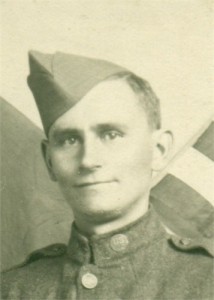 looking at the list my aunts had made about what the pictures were about. In that moment, my idea of my grandfather’s service was changed forever. On the list they had written, that the man on the right, or the man in uniform, was Grandpa. The second picture was tagged with, “Castle in France. Owner of castle died in Daddy’s kitchen” and “cooks, who worked under Daddy.” I was instantly intrigued. I spoke to my aunt, Sandy Pattan about it, and found out that indeed, the kitchen was commandeered for the Army’s use, and the owner had been wounded and ran into the kitchen for help. Grandpa tried to save him, but the wounds were too bad, and the owner died right there. The man’s injuries told me that the front was not far from the castle. I suppose you might think I was reaching a little on that thought, but you would be wrong, because as I talked with Aunt Sandy, she told me something else that really clarified the danger my grandfather lived with every day of his time in the service.
looking at the list my aunts had made about what the pictures were about. In that moment, my idea of my grandfather’s service was changed forever. On the list they had written, that the man on the right, or the man in uniform, was Grandpa. The second picture was tagged with, “Castle in France. Owner of castle died in Daddy’s kitchen” and “cooks, who worked under Daddy.” I was instantly intrigued. I spoke to my aunt, Sandy Pattan about it, and found out that indeed, the kitchen was commandeered for the Army’s use, and the owner had been wounded and ran into the kitchen for help. Grandpa tried to save him, but the wounds were too bad, and the owner died right there. The man’s injuries told me that the front was not far from the castle. I suppose you might think I was reaching a little on that thought, but you would be wrong, because as I talked with Aunt Sandy, she told me something else that really clarified the danger my grandfather lived with every day of his time in the service.
It was another day in the castle kitchen, the men were working on the next meal. Suddenly an American soldier ran in and told the cooks to run for the woods. It seemed strange to me that running would be the order they would receive, but remember that Aunt Sandy told me that the cooks had no guns. If they stayed in the castle, they would be sitting ducks, because cooks or not, they were in the American Army, and that made them enemies of the Germans. The reason the men were told to run for the woods…the Germans were coming 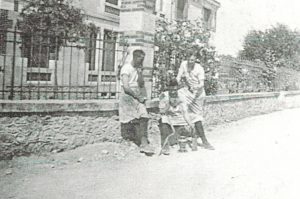 and they couldn’t stop them. The soldier didn’t have to tell the cooks twice. They dropped everything and ran. One of the cooks, while running into the woods, stepped on a dead man. The man had been dead a few days, because the cook’s foot went right into the man’s chest. Aunt Sandy told me that the smell was so bad and so permanent that when they couldn’t get the smell out of the man’s clothes, they had to be burned. I had no idea of the things Grandpa saw, nor of the danger he faced. It gave me a whole new picture of Grandpa Byer’s time in World War I. And I came to clearly realize that no job in the service is less dangerous than another…and least not on the front. It’s no wonder that most men don’t want to talk about the war.
and they couldn’t stop them. The soldier didn’t have to tell the cooks twice. They dropped everything and ran. One of the cooks, while running into the woods, stepped on a dead man. The man had been dead a few days, because the cook’s foot went right into the man’s chest. Aunt Sandy told me that the smell was so bad and so permanent that when they couldn’t get the smell out of the man’s clothes, they had to be burned. I had no idea of the things Grandpa saw, nor of the danger he faced. It gave me a whole new picture of Grandpa Byer’s time in World War I. And I came to clearly realize that no job in the service is less dangerous than another…and least not on the front. It’s no wonder that most men don’t want to talk about the war.

